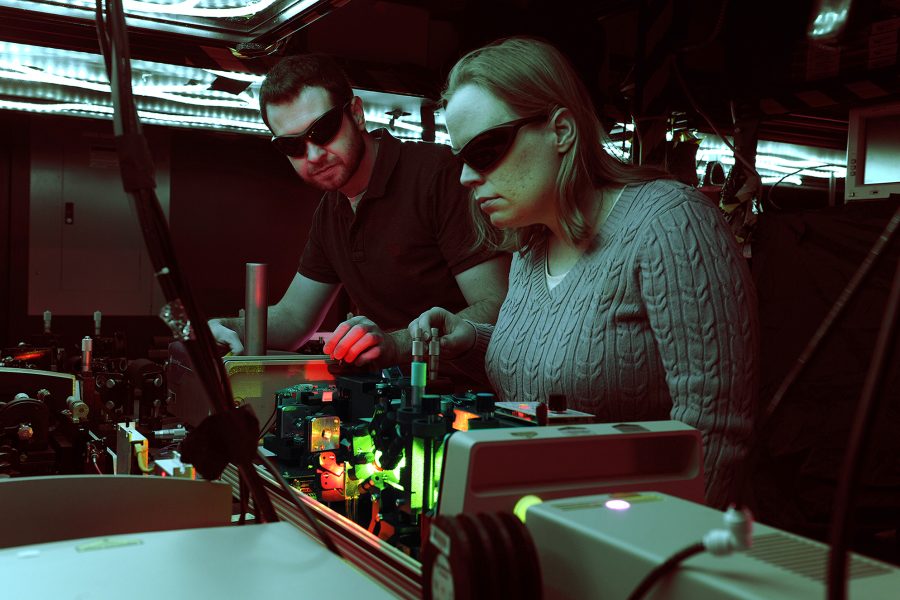Highly precise sensors that could enable aircraft to navigate without satellite-based GPS. Tiny atomic clocks that could ensure perfect timing in the face of GPS jamming. Wideband, low-power antennas that could guarantee secure communications.
These are among the breakthrough capabilities promised by quantum technologies that experts say could give the U.S. Air Force crucial advantages in a future conflict with China—provided, that is, that the U.S. military invests in developing those technologies sooner, not later.
“We have to make decisions about what technologies to pursue, and we have to understand quantum to do that,” said Heather Penney, senior resident fellow at AFA’s Mitchell Institute for Aerospace Studies, and the author of a series of papers on the topic. “We need to be able to focus on high potential—the practical science makes sense, the technology is ready. We need to focus on high payoff—what will actually make a difference to the warfighter.”
Penney highlighted three quantum technologies for reporters at a Jan. 29 rollout event. The three high-potential, high-payoff applications: timing, inertial sensors, and radio frequency receivers.
“Quantum timing integrated with quantum inertial sensors could provide warfighters with an internal, self-contained [precision navigation and timing] capability whose accuracy exceeds current GPS solutions,” Penney writes.
Air Mobility Command experimented with just such a capability in May 2023, placing a quantum magnetic sensor the size of a small crate in the back of a C-17—then measuring changes in the Earth’s magnetic field and using those calculations to navigate the aircraft to its destination.
Air Force leaders increasingly express concern about their aircraft’s dependence on GPS satellites to know where to go. Were GPS jammed or disabled, however, quantum devices like magnetometers and gravimeters could still get aircraft to their destination using precise measurements of the behavior of sub-atomic particles.
Such sensors promise other benefits, including the ability to “detect and map underground tunnels [and] enhance undersea sensing and navigation,” Penney wrote.
Atomic clocks have been around for decades, but quantum tech can make them even more precise in even smaller packages—expanding the number of platforms they could go on and again freeing them from relying on external timing signals that could be jammed.
Such precise instruments could “provide resilient position, navigation, and timing in highly contested environments,” Penney wrote—and they’re not that far off from being a reality, said Michael Hayduk, deputy director of the Air Force Research Lab Information Directorate.
“Timelines are very critical here,” said Hayduk. “When we think about putting these together in quantum-assisted [PNT]-type systems—clocks are pretty much here, one to three years out, and sensors around two to five years as well. So when we talk about military readiness and being able to push technologies out, timing and sensing I think are very critical.”
Finally, both Penney and Hayduk cited the potential of “Rydberg atom”-based receivers—technology that can receive radio signals from across the entire spectrum. Hayduk noted that the Army has conducted research in the area, showing long-range communications with low size, weight, and power requirements, while also being more secure and harder to detect.
Such systems could “improve electronic protection and electronic attack,” Penney wrote.
Learning Quantum
Broadly speaking, quantum refers to “sub-atomic particles and their attributes and behaviors,” Penney wrote in the first of her three-part series. While scientists have understood those attributes and behaviors for years, only recently have they developed “the ability to directly and precisely control, manipulate, and measure quantum particles, attributes, and behaviors,” she added.
The possibilities created by that ability are enormous; Heidi Shyu, undersecretary of defense for research and engineering, has put quantum among her top priorities. The most oft-cited example is quantum computing, using specialized “qubits” instead of classical bits to generate enormous processing power that can solve certain complex problems in ways traditional computers can’t.
But experts are uncertain about how quickly quantum computing will become practical. Other quantum technologies, meanwhile, promise immediate payoffs.
“Timelines are very critical here,” said Michael Hayduk, deputy director of the Air Force Research Lab Information Directorate. “When we think about putting these together in quantum-assisted [positioning, navigation, and timing]-type systems—clocks are pretty much here, one to three years out, and sensors around two to five years as well. So when we talk about military readiness and being able to push technologies out, timing and sensing I think are very critical.”
Hayduk pointed to a 2022 demonstration AFRL put on with partners and allies, including the Five Eyes intelligence network, to place quantum sensors and clocks in a shipping container in the middle of the Pacific ocean. Conducting PNT experiments, they showed the technology could work outside the lab.
“These capabilities must be ruggedized, integrated with platforms, and stressed in realistic combat conditions like operational exercises to demonstrate their value to warfighters,” Penney wrote.
She recommends the Department of the Air Force establish a substantial acquisition program to push quantum towards operational fielding and help bolster the industrial base.
“If we’re going to secure a meaningful advantage, an acquisition program of record is urgently needed if U.S. policymakers are serious about quantum and fielding it to their warfighters,” Penney told reporters during a briefing on her report. “Even an initial minimum viable capability, fielded capability, can kickstart and accelerate the broader quantum ecosystem.”
Fielding capabilities will also help scientists refine them with real-world experience and “help educate our leadership,” said Hayduk.
Given the limited commercial utility, the government must take the lead in funding development, argued Laura Thomas, chief of staff at the startup Infleqtion.
“We have to have the nudge from government to really get it out of the lab and into the field,” Thomas said. “We have these very small batch capabilities … we have an entire trophy case of prototypes that we’ve built, especially from R&D money. But now it’s, how do we build the devices at scale, where the warfighter can use it and truly benefit from it and we can advance more quickly than China.”
